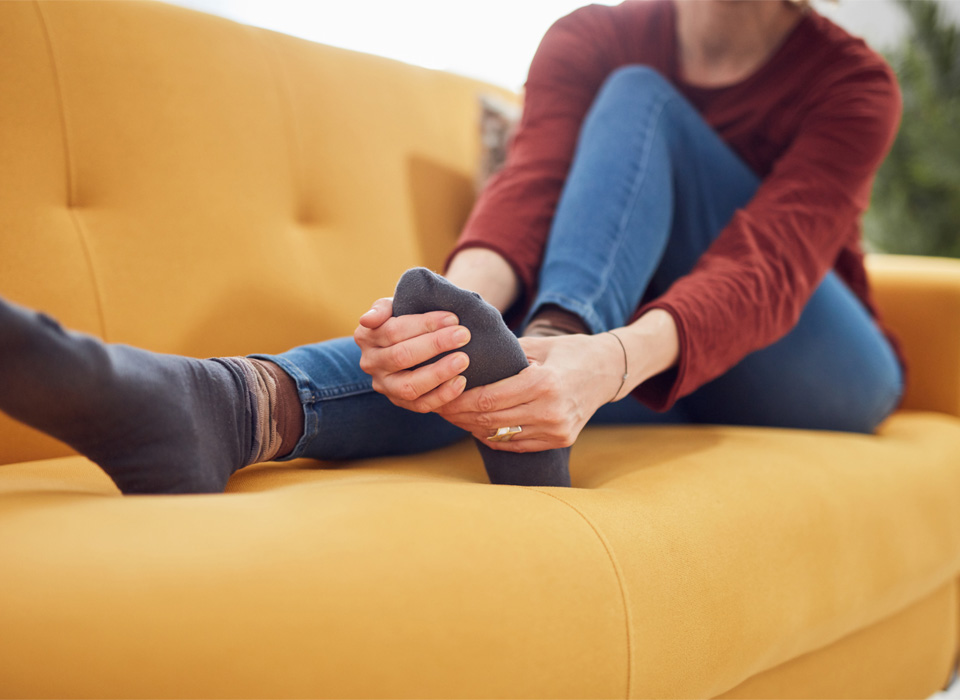Arthritis is a degenerative disease of cartilage (smooth lining of the joint surfaces). Arthritis in the big toe is the most common arthritic condition in the foot, affecting 1 in 40 people over the age of 50.
Most patients complain of pain in the big toe joint, especially when pushing off to walk. Patients notice stiffness and swelling in the big toe, and a large bump on the top part of the toe.
The condition can be particularly life altering— limiting a person’s ability to perform activities that were once enjoyable to them, producing pain and restricting shoe options.
When conservative (non-surgical) treatment options fail, there are potential surgical interventions to help reduce pain and increase function.
Advanced stages of arthritis have traditionally been treated by a surgical fusion of the big toe. In this procedure, the damaged cartilage is removed, and the two bones of the joint are fixed in place to allow them to heal together. Many patients do very well from this procedure with good relief of pain. However, this procedure removes all remaining motion from the big toe joint.
Your toes’ joints are uniquely designed for movement — especially the big toe, which provides most of the force needed to get you going when you are walking and running.
Recently, the FDA approved a synthetic cartilage implant (Cartiva) for use in the United States that has been used in the United Kingdom and Canada since 2009. In July 2016, the first synthetic cartilage implant was performed in the United States. During this procedure, the damaged cartilage is removed and replaced with a biocompatible, biomedical polymer implant. This provides a cartilage-like, compressible, low-friction and durable bearing surface.

Unlike the fusion procedure, which requires prolonged time off the foot, the patients may begin weight bearing immediately after the operation as they can tolerate it. Recent papers have been published in multiple preeminent foot and ankle surgery journals.**
The preliminary results demonstrate:
- excellent pain relief
- preserved, and improved, range of motion
- good functional outcomes with return to activities
- speedy recovery allowing immediate weight bearing
Cartiva patients experience a meaningful reduction in pain two weeks following surgery with the maximum amount of pain reduction starting at six months and beyond.
Cartiva patients return to activities of daily living faster than patients who undergo a fusion procedure, due to fewer restrictions on what they are allowed to do after surgery.
Please make an appointment with Dr. Switaj if interested in learning more about this procedure to assess whether you are an appropriate candidate.
*Please note that Dr. Switaj has no financial relationship or conflict of interest in relation to this product
** Baumhauer JF, Singh D, Glazebrook M, et al. Prospective, Randomized, Multi-centered Clinical Trial Assessing Safety and Efficacy of a Synthetic Cartilage Implant Versus First Metatarsophalangeal Arthrodesis in Advanced Hallux Rigidus. Foot Ankle Int. 2016;37(5):457-469
Baumhauer JF, Singh D, Glazebrook M, et al. Correlation of Hallux Rigidus Grade With Motion, VAS Pain, Intraoperative Cartilage Loss, and Treatment Success for First MTP Joint Arthrodesis and Synthetic Cartilage Implant. Foot Ankle Int. 2017 Oct 9:1071100717735289.5
Daniels TR, Younger SE, Penner MJ, et al. Midterm outcomes of polyvinyl alcohol hydrogel hemiarthroplasty of the first metatarsophalangeal joint in advanced hallux rigidus. Foot Ankle Int. 2017;38(3):243-247Goldberg A, Singh D, Glazebrook M, et al. Association between patient factors and outcome of synthetic cartilage implant hemiarthroplasty vs first metatarsophalangeal joint arthrodesis in advanced hallux rigidus. Foot Ankle Int. 2017 Nov;38(11):1199-1206
